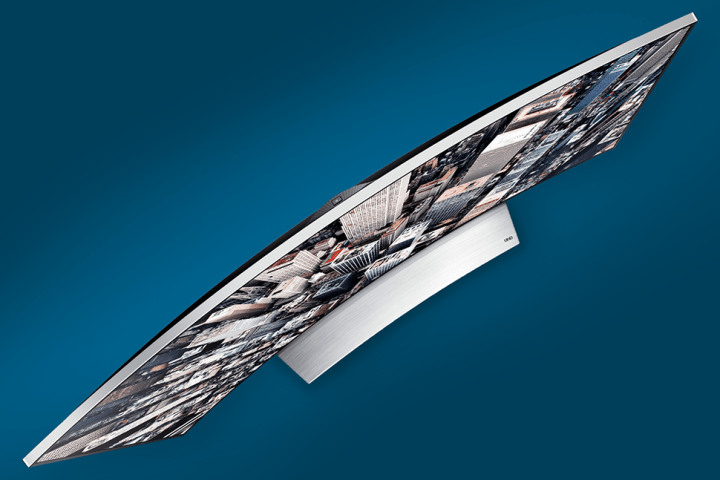
It was totally worth it, because I finally have an answer to the question: Are curved TVs a gimmick?
Yup, and you should still consider buying one. Here’s why.
It’s not all in the image quality
During my marathon viewing session, I actively sought the benefits and drawbacks of the curve. I occasionally slithered to other areas of the room to check for off-axis distortions, I looked at the set while turned on and off, I compared it to my flat-chested 55-inch Panasonic plasma in every conceivable way and, at the end of the day, I determined that watching a curved television provides no significant benefits … or drawbacks, for that matter.
I’ve gained almost 6 pounds, thanks to roughly 32 bags of microwave popcorn washed down with several gallons of Mr. Pibb.
But here’s what a curved TV does do: create a spectacle in your living room.
A curved television makes a bold first impression — you can’t not stare at it. The gentle radius screams for attention while simultaneously seducing you into a trance-like state. When guests to my home saw it, there could have been a carnival of dancing monkeys dressed in tutus in my living room and no one would have noticed because they were all staring at the TV.
Comments ranged from “What is that?” to, “Oh! This is that … thing I’ve been reading about.” and “Wow. It’s … like … curved!”
And of course, the inevitable, “What a gimmick.” To which I have to reply, “What’s wrong with that?”
We like gimmicks
The Oxford Dictionary defines a gimmick as “a trick or device intended to attract attention, publicity, or business.”
Samsung’s best performing TV this year happens to be curved, and the curve itself could be seen as a gimmick. Is that really a bad thing?
The term “gimmick” usually bears a negative connotation, as if the gimmicks that marketers use to make their products attractive are some sort of ploy to fool us into handing over more money than we should — perhaps robbing our children of their college funds or putting our mortgage payments in unnecessary peril.
Rubbish.

First of all, you control how you spend your own money, so let’s dismiss the notion that marketers can reach into our pockets and pry open our wallets with a good gimmick while we watch on helplessly.
Second, consumers love gimmicks. A gimmick, by its definition, makes a product stand out and appear unique; many folks like to have unique things and are willing to pay for them.
Finally, knocking a curve as an unnecessary feature on a luxury product that is unnecessary by its very definition is totally ludicrous. Nobody gets pissed off because Maserati puts vents on its quarter panels when they serve no real purpose other than looking cool. Suggesting that by adding a curve to a television is somehow doing something unscrupulous is just silly.
Looking cool is a totally legitimate function, and curved TVs clearly have that covered.
Curves don’t hurt
If any TV trend should have riled us up to cry “gimmick,” it’s a feature that’s not only useless, but actually degrades picture quality in the interest of aesthetics. Like ultra-thin TVs — a trend that not many consumers seem to criticize, but that has actively made TVs look worse.
Yes, in the pursuit of a sleeker, sexier TV, manufacturers placed form over function, and in doing so, sacrificed some key performance aspects.
When companies compete for consumer attention, consumers usually win.
Today, edge-lighting is miles ahead of where it was, and we can have our thin TVs, but edge-lit TVs still can’t match the even lighting or contrast of full array backlit TVs. And as anyone who has owned a paper-thin TV can tell you, they sound terrible too – worse than the older TVs they often replaced. Perhaps that’s why manufacturers like Vizio are pushing entire lines of televisions featuring full arrays of backlights. They just look and sound better.
We like fads
If there’s anything as ubiquitous in the U.S. as a television, it’s a pair of jeans. Just as there is a TV in nearly every household, there are a pair of jeans in nearly every wardrobe. We’ve been wearing denim for decades, and as time has marched on, fashion designers have had to come up with clever new ways to make jeans seem fresh and appealing. And we’ve eaten it up.
Bell-bottoms, acid-washed, stone-washed, jeans with holes slashed in the knees, flared jeans, high-rise jeans, low-cut jeans, boot cut … we could go on forever here. The point is, we like to change it up and keep things fresh, and fads do that. They also give us something to laugh at when we look back on past decades.
Is the curved TV a fad? That’s up to consumers. Check back with us in about 15 years.
If you don’t like it, don’t buy one
Manufacturers like Samsung and LG are in fierce competition to out-innovate one another. When companies compete for consumer attention, consumers usually win. Curved TVs are just another way to do that.
We don’t like that Samsung’s very best television this year is only available in a curved model. We’d like to see consumers get the option to pick one or the other, while still getting Samsung’s best. We also didn’t like it that OLED televisions were initially available only as curved models, but LG now offers a couple premium flat models. The issue that curved TVs couldn’t be wall-mounted has now also been addressed, though we would never wall-mount one ourselves.
At the end of the day, the choice to go with a curved TV should be a personal one, and it can be made confident in the knowledge that it requires no real sacrifices other than several hundred additional dollars. If you like the look of a curved television and cost is no object, go for it. We anticipate this unique design will provide years of entertainment for both you and your guests.



